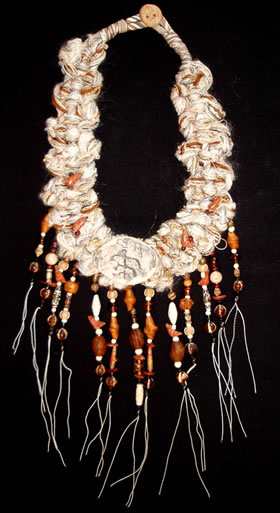

| Shamanism and Creativity By Sandra Harner © Shamanism, Fall/Winter 1999, Vol. 12, No. 2 One of the great surprises that shamanism affords is the joy of the unknown and that the unknown is joyous. There is a sense of wholeness that proceeds from the creativity that is inherent in the shamanic journey. Although shamanism and creativity are not commonly thought of together, a relatively superficial survey of studies of creativity reveals that the shamanic journey speaks to two of the most unknown, mysterious, and abstract elements of the creative process, as frequently defined. Further, recent research focusing on the relationship between structure and creativity1 can be directly applied to the experiences of shamanic journeying. Not only does the shamanic journey have elements of the creative process in it as a creative act, it can also be exercised in the service of productive creativity. Journeying increases access to creativity and stimulates its cultivation. By viewing creativity through the experience of the shamanic journey, we begin to see that creativity is not a special domain limited to the gifted few, nor can it be reduced to a rote algorithm. Instead, dormant potential can be enlivened and unleashed across multiple disciplines.  Shaman Woman by Allyson Rickard. Woven necklace created from stone, bone, clay and paper beads. From the petroglyph fields of Puako Hawaii comes a contemporary version of a shaman woman giving birth to visions of human justice for all peoples of the world. The central image is from a photo of a petroglyph taken at Puako on the Big Island of Hawaii. From a number of perspectives, researchers have attempted to define creativity and describe the creative personality. An early elaboration by Wallas2 defined four stages of the creative process: preparation, incubation, illumination, and verification. Since that time, others have developed schema for understanding the elements of creativity.3 Attempts to examine the creative personality have been remarkably heterogeneous, with no clear findings of both necessary and sufficient qualities of creativity. Some descriptors emerged from research on the thought processes of creative persons. They include flexibility, originality, and fluency.4 Characteristic of exceptionally creative people are a variety of qualities such as persistence, independence, unconventionality, 5 and others which, in themselves, may or may not determine creativity. Much remains to be learned about the process and personality aspects of creative expression. Fortunately, however, the creative experience does not have to wait for scientific explanation to validate it. We can learn from what we experience and test the hypotheses proposed by scholars in the field. As we learn about the process and from the experience of creativity, we lay the groundwork for consciously cultivating creativity. Examining the shamanic journey experience may help clarify the mechanisms of the creative process. Although many address creativity with more or fewer than the four stages proposed above, the elements Wallas proposed form a useful framework for considering how the shamanic journey supports creativity and where it may fit into Western psychology's understanding of the creative process. Something is a problem because it cannot be resolved in the usual ways, implying that some active attempt has been unsuccessful, requiring further preparation. The altered state of consciousness in the shamanicjourney provides an opportunity for planned incubation, set apart from a direct attack on the problem. It is common that within the shamanic divination journey, thejourneyer receives a revelation of quite unexpected content-an inspiration. Then, that inspiration must be put into practice and verified, thus completing the process with the creative act. Most recently, research has focused on just this issue of learned creative thinking.6 The shamanic journey itself becomes the active vehicle for two aspects of the process: the incubation by way of the changed state of consciousness and the inspiration by way of the content of the experience. Framing the divinatory question or problem and interpreting the journey are skills which can be learned and enhanced by repeated use of the method and consequent mapping of the individual's cosmology. The integration and application of the inspiration in the material world builds trust in the process as a result of experience. What may have been an act of courage becomes one of deeply mindful integrity. One enters the experience at will and immerses oneself in it while it is happening. Then one translates the experience and applies it in a conscious, reasoned manner, after an ordinary reality evaluation. |
Articles
Please consider joining the Circle and receive the Foundation's journal, the Shamanism Annual as part of your benefits. |